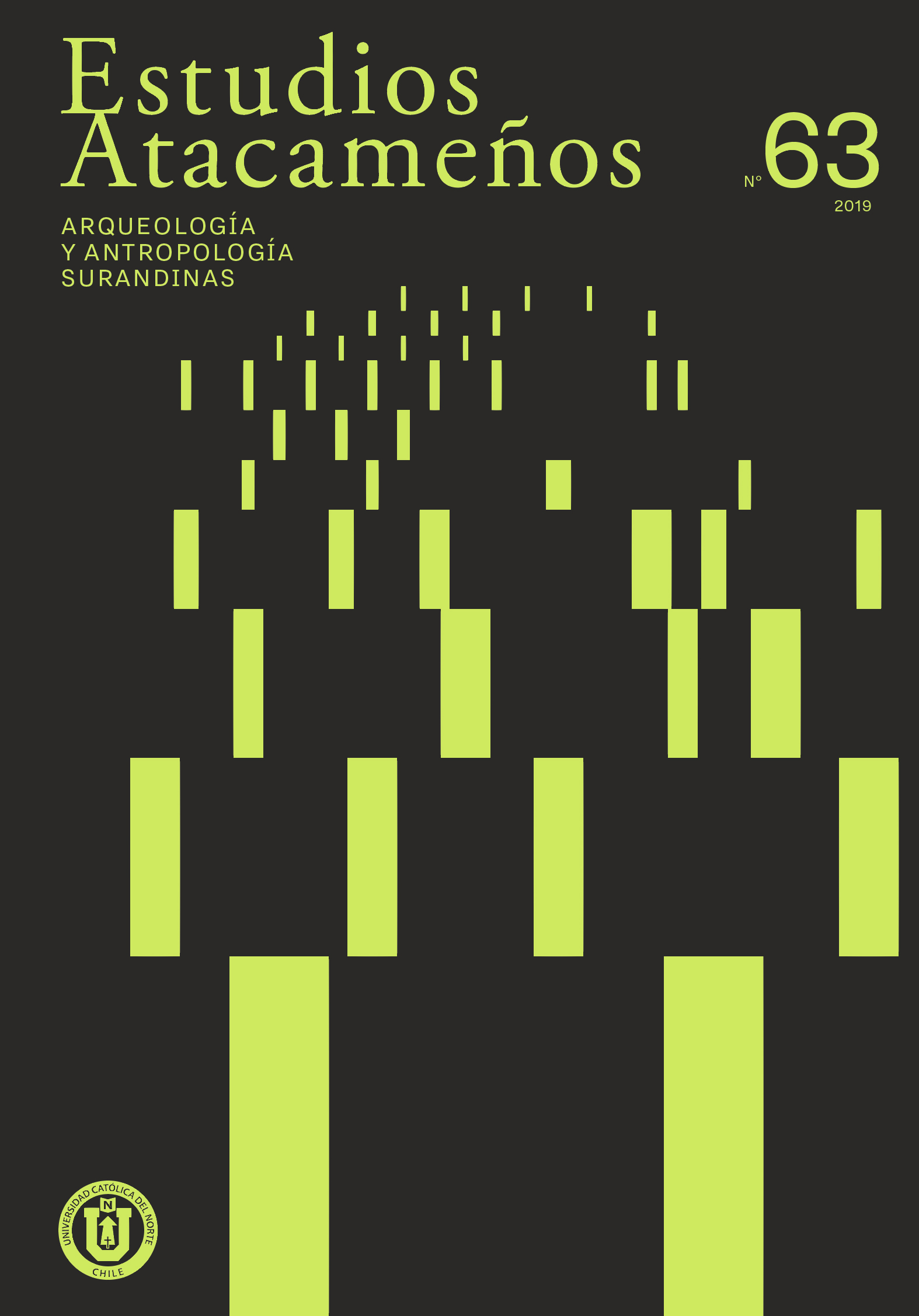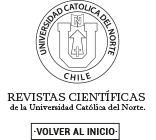Appendicular degenerative joint disease among hunter-gatherers from the southern point of La Plata basin
DOI:
https://doi.org/10.22199/issn.0718-1043-2019-0025Keywords:
lower Parana wetlands, osteoarthrosis, late HoloceneAbstract
Degenerative joint disease (DJD) is one of the commonest bone pathologies in past and present societies. It is characterized by fragmentation of the synovial joint cartilage, whose etiology is related to individual´s intrinsic and extrinsic factors. The objective of this work is to explore DJD prevalence in the appendicular skeleton of late Holocene hunter-gathers from the southern point of La Plata Basin (Argentina). In addition, this work evaluates the relationship between DJD and the age and sex of the individuals, their midshaft robusticity indices, body size, archaeological sites and units. To this end, the presence of marginal and surface osteophytes, porosity and/or eburnation were registered on 921 articular surfaces. The results show that DJD has a prevalence of 11.29% in the total sample, and it manifests mainly among individuals females above 35 years of age, in small body sizes and in long bones with high midshaft robusticity indices. These results suggest that age, hormones, genetics and mechanical factors might have influenced the presence of DJD.
Downloads
References
Acosta, A. y Loponte, D. (2013). Complejidad social y estrategias de subsistencia de las poblaciones cazadoras-recolectoras del humedal del Paraná inferior. Cuadernos del Instituto Nacional de Antropología y Pensamiento Latinoamericano. Series Especiales, 1(4), 60-74.
Acosta, A., Loponte, D. y Tchilingurian, P. (2010). Análisis comparativo sobre la estructura y los procesos de formación de los depósitos arqueológicos en el humedal del río Paraná inferior (delta del Paraná). En Cocco, G. y Feuillet Terzaghi, M. R. (Eds.). Arqueología de cazadores recolectores en la Cuenca del Plata (pp. 191-208). Santa Fe: Centro de Estudios Hispanoamericanos.
Anderson, S. y Loesser, R. (2010). Why is osteoarthritis an age-related disease? Best Practice y Research: Clinical Rheumatology, 24(1), 15-26.
Arrieta, M. y Mendonça, O. (2011). Enfermedad degenerativa articular y uso del cuerpo en Rincón Chico 21 (Santa María, Catamarca). Revista Argentina de Antropología Biológica, 13(1), 3-17.
Barceló, J. (2008). Arqueología y estadística. Introducción al estudio de la variabilidad de las evidencias arqueológicas (Vol. 1). Barcelona: Bellaterra, Servicio de Publicaciones de la Universidad Autónoma de Barcelona.
Birkbeck, D., Failla, J., Hoshaw, S., Fyhrie, D. y Schaffer, M. (1997) The interosseous membrane affects load distribution in the forearm. Journal of Hand Surgery, 22A, 975-980.
Bökönyi, S. (1970). A new method for the determination of the number of individuals on animal bone material. American Journal of Archaeology, 74, 291-292.
Bonomo, M., Capdepont, I. y Matarrese, A. (2009). Alcances en el estudio de colecciones. Los materiales arqueológicos del delta del río Paraná depositados en el Museo de La Plata (Argentina). Arqueología Suramericana, 5(1), 68-101.
Bonomo, M., Politis, G. y Gionotti, C. (2011). Montículos, jerarquía social y horticultura en las sociedades indígenas del delta del río Paraná (Argentina). Latin American Antiquity, 22(3), 297-333.
Bridges, P. (1991). Degenerative joint disease in hunter-gatherers and agriculturalists from the Southeastern United States. American Journal of Physical Anthropology, 85, 379-391.
Brooks, S. T. y Suchey, J. M. (1990). Skeletal age determination based on the os pubis: a comparison of the Acsádi-Nemeskéri and Suchey-Brooks methods. Human Evolution, 5(3), 227-238.
Buckwalter, J. y Martin, J. (2006). Osteoarthritis. Advances Drug Delivery Reviews, 58, 150-167.
Buikstra, J. y Ubelaker, D. (1994). Standards for Data Collection from Human Skeletal Remains. Arkansas: Arkansas Archeological Survey.
Byrd, J., y LeGarde, C. (2014). Osteometric sorting. En Adams, B. y Byrd, J. (Eds.). Commingled Human Remains. Methods in Recovery, Analysis, and Identification (pp. 167-191). Oxford: Elsevier.
Caggiano, M. A., Flores, O. B., Méndez, M. G. y Salceda, S. A. (1978). Nuevos aportes para el conocimiento antropológico del Delta del Paraná. Relaciones de la Sociedad Argentina de Antropología, XII, 155-174.
Cerda, J., Vera, C. y Rada, G. (2013). Odds ratio: aspectos teóricos y prácticos. Revista Médica de Chile, 141, 1329-1335.
Coggon, D., Croft, P., Kellingray, S., Barret, D., McLaren, M. y Cooper, C. (2000). Occupational physical activities and osteoarthritis of the knee. Arthritis and Rheumatism, 43(7), 1443-1449.
Cooper, C., Javaid, M. y Arden, N. (2014). Epidemiology of osteoarthritis. En Arden, N., Blanco, F., Cooper, C., Guermazi, A., Hayashi, D., Hunter, D., Javaid, K., Rannou, F., Reginster J.-Y y Roemer, F. (Eds.). Atlas of osteoarthritis (pp. 21-36). London: Springer Healthcare.
Dietrich, W., Haitel, A., Holzer, G., Huber, J., Kolbus, A. y Tschugguel, W. (2006). Estrogen receptor-β is the predominant estrogen receptor subtype in normal human synovia. Society for Ginecologic Investigation, 13(7), 512-517.
Fabra, M., González, C. y Salega, S. (2012). Modos de vida e historia biológica de poblaciones de las sierras y las llanuras de Córdoba (Argentina): aproximaciones desde el registro bioarqueológico. Revista Argentina de Antropología Biológica, 14 (Número especial), 87-104.
Farro, M. (2011). Colecciones de cráneos, fotografías y manuscritos en el desarrollo de la antropología física y de la etnografía lingüística en la Argentina a fines del siglo XIX. En Lopes, M.M. y Heizer, A. (Eds.). Colecionismos, práticas de campo e representações (pp. 93-104). Brasil: EDUEPB.
Felson, D. (2000). Osteoarthritis: New insights. Annals of Internal Medicine, 133, 635-646.
Felson, D. (2013). Osteoarthritis as a disease of mechanics. Osteoarthritis and Cartilage, 21, 10-15.
Flensborg , G. (2016). Health and disease of hunter-gatherer groups from the eastern Pampa–Patagonia transition (Argentina) during the Late Holocene. Anthropological Science, 124(1), 29-44.
Frost, H. (1987). Bone “mass” and the “mechanostat”: A proposal. The Anatomical Record, 219, 1-9.
Fucks, E., D’Amico, G., Pisano, M. F. y Nuccetelli, G. (2017). Evolución geomorfológica de la región del Gran La Plata y su relación con eventos catastróficos. Revista de la Asociación Geológica Argentina, 74(2), 141-154.
Gaspary, F. (1950). Investigaciones arqueológicas y antropológicas en un “Cerrito” de la Isla Los Marinos (Vol. XXIII). Córdoba: Publicaciones del Instituto de Arqueología, Lingüística y Folklore “Dr. Pablo Cabrera”, Universidad Nacional de Córdoba.
Jurmain, R. (1990). Paleoepidemiology of a Central California prehistoric population from CA-ALA-329: II. Degenerative disease. American Journal of Physical Anthropology, 83, 83-94.
Jurmain, R. (1991). Degenerative changes in peripheral joints as indicators of mechanical stress: Opportunities and limitations. International Journal of Osteoarchaeology, 1, 247-252.
Kaprio, J., Kujala, U., Peltonen, L. y Koskenvuo, M. (1996). Genetic liability to osteoarthritis may be greater in women than men. British Medical Journal, 313(7051), 232.
Klaus, H., Spencer Larsen, C. y Tam, M. (2009). Economic intensification and degenerative joint disease: Life and labor on the postcontact North Coast of Peru. American Journal of Physical Anthropology, 139, 204-221.
Knüsel, C., Goggel, S. y Lucy, D. (1997). Comparative degenerative joint disease of the vertebral column in the medieval monastic cemetery of the Gilbertine Priory of St. Andrew, Fishergate, York, England. American Journal of Physical Anthropology, 103, 481-495.
Lai, P. y Lovell, N. (1992). Skeletal markers of occupational stress in the fur trade: A case study from a Hudson's Bay Company Fur Trade Post. International Journal of Osteoarchaeology, 2, 221-234.
Lieverse, A., Weber, A., Bazaliiskii, V., Goriunova, O. y Savel’ev, N. (2007). Osteoarthritis in Siberia’s Cis-Baikal: Skeletal indicators of hunter-gatherer adaptation and cultural change. American Journal of Physical Anthropology, 132, 1-16.
Loponte, D. (2008). Arqueología del Humedal del Paraná Inferior. En Acosta, A. y Loponte, D. (Eds.), Arqueología de la Cuenca del Plata. Serie Monográfica 1. Buenos Aires: Ediciones del Riel.
Loponte, D. y Acosta, A. (2016). Los contextos Goya-Malabrigo del noreste argentino. Cuadernos do CEOM, 29(45), 125-187.
Loponte, D., Acosta, A. y Corriale, M. J. (2016). Isotopic trends in the diets of hunter-gatherers of the lower Paraná wetland, South America. Journal of Archaeological Science: Reports, 9, 259-274.
Loponte, D., Acosta, A. y Mucciolo, L. (2012). Contribución a la arqueología del delta del Paraná: El nivel acerámico del sitio Isla Lechiguanas 1. Comechingonia, 16(1), 229-268.
Loponte, D., Acosta, A. y Tchilingurian, P. (2015). El sitio arqueológico Escuela 31. Revista del Museo de La Plata, Arqueología, 14(89), 27R.
Lothrop, S. (1932). Indians of the Parana Delta, Argentina. Annals of the New York Academy of Scienses, 33, 77-232.
Lovejoy, O., Meindl, R., Pryzbeck, T. y Mensforth, R. (1985). Chronological Metamorphosis of the Auricular Surface of the Ilium: A New Method for the Determination of Adult Skeletal Age at Death. American Journal of Physical Anthropology, 68, 15-28.
Luna, L., Aranda, C. y Amorim Alves, A. (2017). Reflexiones sobre el relevamiento y análisis comparativo de patologías osteoarticulares en restos esqueletales humanos. Revista Argentina de Antropología Biológica, 19(1), 1-5.
Mazza, B. (2010). Cerro Lutz: Aproximaciones al estudio de las prácticas mortuorias de las sociedades cazadoras-recolectoras del humedal del Paraná inferior. Revista La Zaranda de Ideas, Revista de Jóvenes Investigadores en Arqueología, 6, 91-116.
Mazza, B. (2015). Colecciones antiguas, datos nuevos: Primeros resultados del análisis de las colecciones bioarqueológicas del humedal del Paraná inferior. Revista del Museo de Antropología, 8(1), 133-146.
Mazza, B. (2016). Determinación sexual en huesos largos de miembros superiores e inferiores para sociedades cazadoras-recolectoras del sector meridional de la cuencia del Plata, Argentina. Revista Española de Antropología Física, 37, 12-27.
Mazza, B. (2018). Entheseal changes among late Holocene hunter-gatherers from the southern extreme of La Plata basin (Argentina). Archaeological and Anthropological Sciences. doi: 10.1007/s12520-018-0638-2.
Mazza, B. y Loponte, D. (2012). Las prácticas mortuorias en el humedal del Paraná inferior. Arqueología Iberoamericana, 13, 3-21.
Mazza, B., Acosta, A., Guarido, A., Buc, N. y Loponte, D. (2018). Anthropogenic modifications on archaeological human bones from the lower Paraná River Basin (Argentina). Journal of Archaeological Science: Reports, 20, 647-661. DOI: 10.1016/j.jasrep.2018.06.013.
Meindl, R. y Lovejoy, O. (1985). Ectocranial suture closure: A revised method for the determination of skeletal age at death based on the lateral-anterior sutures. Journal of Physical Anthropology, 68, 57-66.
Nikita, E., Mattingly, D. y Lahr, M. M. (2013). Methodological considerations in the statistical analysis of degenerative joint and disc disease. International Journal of Paleopathology, 3(2), 105-112.
Pachenkina, E. y Delgado, M. (2006). Dimensions of health and social structure in the Early Intermediate period cemetery at Villa El Salvador, Peru. American Journal of Physical Anthropology, 131, 218-235.
Pearson, O. M. (2000). Activity, Climate, and Postcranial Robusticity. Current Anthropology, 41(4), 569-607.
Pearson, O. M. y Lieberman, D. (2004). The aging of Wolff’s “law”: Ontogeny and responses to mechanical loading in cortical bone. Yearbook of Physical Anthropology, 47, 63-99.
Pearson, O. M. y Millones, M. (2005). Rasgos esqueletales de adaptación al clima y a la actividad entre los habitantes aborígenes de Tierra del Fuego. Magallania, 33(1), 37-50.
Pérez, M., Acosta, I., Naranjo, G. y Malec, L. (2013). Uso de la alfarería y conductas alimenticias en el humedal del Paraná inferior a través del análisis de ácidos grasos. Cuadernos del Instituto Nacional de Antropología y Pensamiento Latinoamericano. Series Especiales, 1(1), 26-45.
Phenice, T. (1969). A new developed visual method of sexing in the os pubis. American Journal of Physical Anthropology, 30, 297-301.
Politis, G., Bonomo, M., y Mareira, G. (2015). Análisis de la colección del Túmulo II de Brazo Largo (Islas del Ibicuy, provincia de Entre Ríos). Actas del 6to Encuentro de Discusión Arqueológica del Nordeste Argentino (p. 36). Gualeguaychú, Entre Ríos, Argentina.
Pontzer, H., Raichlen, D., Wood, B., Mabulla, A., Racette, S., y Marlowe, F. (2012). Hunter-gatherer energetics and human obesity. Plos One, 7(7), 1-8.
Puranen, J., Ala-Ketola, L., Peltokallio, P. y Saarela, J. (1975). Running and primary osteoarthritis of the hip. British Medical Journal, 2(5968), 424-425.
Rannou, F. (2014). Pathophysiology of osteoarthritis. En Arden, N., Blanco, F., Cyrus, C., Guermazi, A., Hayashi, D., Hunter, D., Javaid, K., Rannou, F., Reginster J.-Y. y Roemer, F. (Eds.). Atlas of osteoarthritis (pp. 37-68). London: Springer Healthcare.
Richette, P., Corvol, M. y Bardin, T. (2003). Estrogens, cartilage, and osteoarthritis. Joint Bone Spine, 70(4), 257-262.
Rogers, J. y Waldron, T. (1995). A field guide to joint disease in archaeology. Inglaterra: John Wiley y Sons.
Rojas-Sepúlveda, C., Ardagna, Y. y Dutour, O. (2006). Paleoepidemiology of vertebral degenerative disease in pre-columbian Muisca series from Colombia. American Journal of Physical Anthropology, 135, 416-430.
Rojas-Sepúlveda, C. y Dutour, O. (2014). Enfermedad articular degenerativa y cambios entesiales en seis colecciones óseas prehispánicas del noroccidente de América del sur. Chungara. Revista de Antropología Chilena, 46(1), 153-169.
Roman-Blas, J., Castañeda, S., Largo, R. y Herrero-Beaumont, G. (2009). Osteoarthritis associated with estrogen deficiency. Arthritis Research y Therapy, 11(5), 241.
Ruff, C., Scott, W. y Liu, A. (1991). Articular and diaphyseal remodeling of the proximal femur with changes in body mass in adults. American Journal of Physical Anthropology, 86, 397-413.
Sacur Silvestre, R., Buc, N., Acosta, A. y Loponte, D. (2013). Estrategias de captura de presas y sistemas de armas de los cazadores-recolectores que habitaron el humedal del Paraná inferior: una aproximación experimental y arqueológica. Comechingonia, 17, 27-57.
Scabuzzo, C. (2012). Estudios bioarqueológicos de marcadores de estrés ocupacional en cazadores-recolectores pampeanos del Holoceno temprano-medio. Análisis de la serie esqueletal de Arroyo Seco 2. Revista Argentina de Antropología Biológica, 14(1), 17-31.
Scabuzzo, C., Ramos van Raap, A., Bonomo, M. y Politis, G. (2015). Estudios bioarqueológicos en el sitio Los Tres Cerros 1 (Delta Superior del río Paraná, Entre Ríos, Argentina). Boletim do Museu Paraense Emílio Goeldi. Ciências Humanas, 10(2), 509-535.
Scheuer, L. y Black, S. (2000). Developmental Juvenil Osteology. Londres: Elsevier Academic Press.
Sniekers, Y. (2009). Estrogen effects on cartilage and bone changes in models for osteoarthritis (Tesis doctoral). Erasmus Universiteit Rotterdam, Holanda.
Spector, T. y MacGregor, A. (2004). Risk factors for osteoarthritis: genetics. Osteoarthritis and Cartilage, 12, S39-S44.
Stuiver, M., y Reimer, P. J. (1993). Extended 14C data base and revised CALIB 3.0 14C age calibration program. Radiocarbon, 35, 215-230.
Suby, J., Zangrando, A. y Piana, E. (2011). Exploraciones osteológicas de la salud de las poblaciones humanas del canal Beagle. Relaciones de la Sociedad Argentina de Antropología, XXXVI, 249-270.
Sutton, A., Muir, K., Mockett, S. y Fentem, P. (2001). A case-control study to investigate the relation between low and moderate levels of physical activity and osteoarthritis of the knee using data collected as part of the Allied Dunbar National Fitness Survey. Annals of the Rheumatic Diseases, 60, 756-764.
Vignati, M. A. (1960). El indigenado en la pcia. de Buenos Aires. Anales de la Comisión de Investigación Científica, I, 95-182.
Weiss, E. (2005). Understanding osteoarthritis patterns: An examination of aggregate osteoarthritis. Journal of Paleopathology, 16(1), 87-98.
Weiss, E. (2006). Ostearthritis and body mass. Journal of Archaeological Science, 33, 690-695.
Weiss, E. y Jurmain, R. (2007). Osteoarthritis revisited: A contemporary review of aetiology. International Journal of Osteoarchaeology, 17, 437-450.
Wescott, D. (2006). Effect of mobility on femur midshaft external shape and robusticity. American Journal of Physical Anthropology, 130(2), 201-213.
Wescott, D. (2008). Biomechanical analysis of humeral and femoral structural variation in the Great Plains. Plains Anthropologist, 53 (207), 333-355.
White, T. (1953). A method of calculating the dietary percentage of various food animals utilized by aboriginal peoples. American Antiquity, 18(4), 396-398.
Woo, E. y Sciulli, P. (2013). Degenerative joint disease and social status in the terminal late Archaic period (1000-500 B.C.) of Ohio. International Journal of Osteoarchaeology, 23(5), 529-544.
Zhang, Y. y Jordan, J. (2010). Epidemiology of osteoarthritis. Clinics in Geriatric Medicine, 26(3), 355-369.
Downloads
Published
Issue
Section
License

All works published in Revista Estudios Atacameños (ISSN on line:0718-1043) Revista Estudios Atacameños Creative Commons International 4.0 attribution (CC BY 4.0) licence.
Authors remain the owners of their work and may republish their articles elsewhere without having to request permission, as long as they indicate that the work was originally published in Revista Estudios Atacameños (ISSN on liine:0718-1043).












